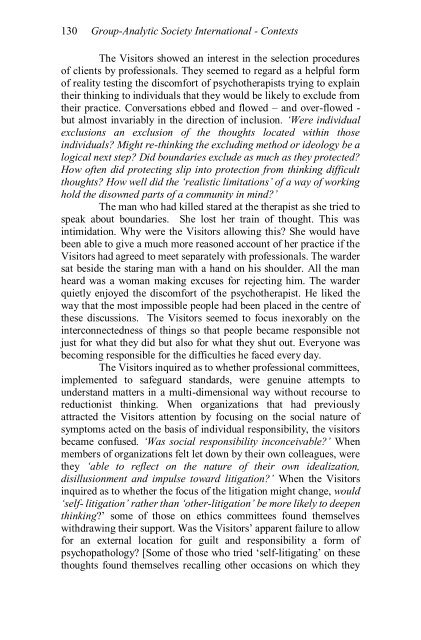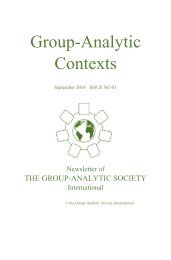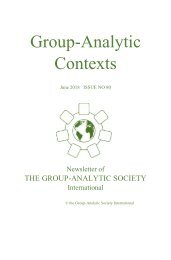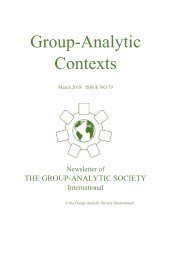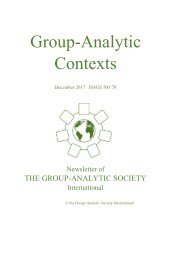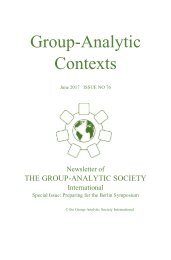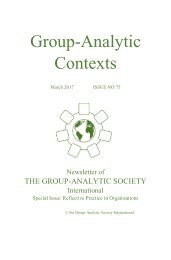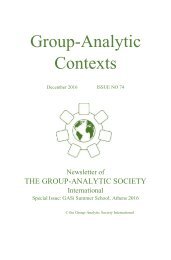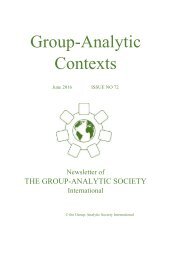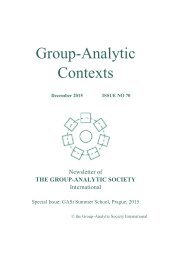Group Analytic Contexts, Issue 77, September 2017
Newsletter of the Group Analytic Society International
Newsletter of the Group Analytic Society International
You also want an ePaper? Increase the reach of your titles
YUMPU automatically turns print PDFs into web optimized ePapers that Google loves.
130 <strong>Group</strong>-<strong>Analytic</strong> Society International - <strong>Contexts</strong><br />
The Visitors showed an interest in the selection procedures<br />
of clients by professionals. They seemed to regard as a helpful form<br />
of reality testing the discomfort of psychotherapists trying to explain<br />
their thinking to individuals that they would be likely to exclude from<br />
their practice. Conversations ebbed and flowed – and over-flowed -<br />
but almost invariably in the direction of inclusion. ‘Were individual<br />
exclusions an exclusion of the thoughts located within those<br />
individuals? Might re-thinking the excluding method or ideology be a<br />
logical next step? Did boundaries exclude as much as they protected?<br />
How often did protecting slip into protection from thinking difficult<br />
thoughts? How well did the ‘realistic limitations’ of a way of working<br />
hold the disowned parts of a community in mind?’<br />
The man who had killed stared at the therapist as she tried to<br />
speak about boundaries. She lost her train of thought. This was<br />
intimidation. Why were the Visitors allowing this? She would have<br />
been able to give a much more reasoned account of her practice if the<br />
Visitors had agreed to meet separately with professionals. The warder<br />
sat beside the staring man with a hand on his shoulder. All the man<br />
heard was a woman making excuses for rejecting him. The warder<br />
quietly enjoyed the discomfort of the psychotherapist. He liked the<br />
way that the most impossible people had been placed in the centre of<br />
these discussions. The Visitors seemed to focus inexorably on the<br />
interconnectedness of things so that people became responsible not<br />
just for what they did but also for what they shut out. Everyone was<br />
becoming responsible for the difficulties he faced every day.<br />
The Visitors inquired as to whether professional committees,<br />
implemented to safeguard standards, were genuine attempts to<br />
understand matters in a multi-dimensional way without recourse to<br />
reductionist thinking. When organizations that had previously<br />
attracted the Visitors attention by focusing on the social nature of<br />
symptoms acted on the basis of individual responsibility, the visitors<br />
became confused. ‘Was social responsibility inconceivable?’ When<br />
members of organizations felt let down by their own colleagues, were<br />
they ‘able to reflect on the nature of their own idealization,<br />
disillusionment and impulse toward litigation?’ When the Visitors<br />
inquired as to whether the focus of the litigation might change, would<br />
‘self- litigation’ rather than ‘other-litigation’ be more likely to deepen<br />
thinking?’ some of those on ethics committees found themselves<br />
withdrawing their support. Was the Visitors’ apparent failure to allow<br />
for an external location for guilt and responsibility a form of<br />
psychopathology? [Some of those who tried ‘self-litigating’ on these<br />
thoughts found themselves recalling other occasions on which they


